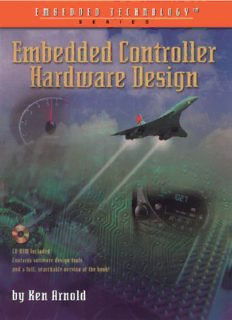Table Of ContentEmbedded Controller
Hardware Design
by Ken Arnold
This Page Intentionally Left Blank
A Volume in the
Embedded Technology Series
TM
Embedded Controller
Hardware Design
by Ken Amold
AMSTERDAM (cid:12)9 BOSTON (cid:12)9 HEIDELBERG (cid:12)9 LONDON
NEW YORK (cid:12)9 OXFORD (cid:12)9 PARIS (cid:12)9 SAN DIEGO
SAN FRANCISCO (cid:12)9 SINGAPORE (cid:12)9 SYDNEY (cid:12)9 TOKYO
Newnes
Newnes is an imprint of Elsevier Science.
Copyright (cid:14)9 2004, Elsevier Science (USA). All rights reserved.
No part of this publication may be reproduced, stored in a retrieval
system, or transmitted in any form or by any means, electronic,
mechanical, photocopying, recording, or otherwise, without the
prior written permission of the publisher.
~ Recognizing the importance of preserving what has been written,
Elsevier Science prints its books on acid-free paper whenever possible.
Library of Congress Cataloging-in-Publication Data
ISBN: 1-878707-52-3
British Library Cataloguing-in-Publication Data
A catalogue record for this book is available from the British Library.
The publisher offers special discounts on bulk orders of this book.
For information, please contact:
Manager of Special Sales
Elsevier Science
200 Wheeler Road
Burlington, MA 01803
Tel: 781-313-4700
Fax: 781-313-4880
For information on all Newnes publications available, contact our
World Wide Web home page at: http://www.newnespress.com
1098765432 1
Printed in the United States of America
Dedication
This book is dedicated in memory of my father, Kenneth Owen Arnold,
who always encouraged me to follow my dreams. When other adults
discouraged me from entering the engineering field, he told me, "If you
really like what you're doing and you're good at it, you will be successful."
Nowadays I get paid to have fun doing things I'd do for free anyway, so
that meets my definition of success! Thanks, Dad.
vi
Acknowledgment
This book is a direct result of contributions from many of the students I
have been fortunate enough to have in my embedded computer engineering
courses at the University of California~San Diego extension. They have
provided a valuable form of feedback by sharing their notes and pointing
out weaknesses in the text and in-class presentations. Some sections of
this text were also provided by David Fern and Steven Tietsworth.
I would also like to thank my family for supporting me and, Mary, Nikki,
Kenny, Daniel, Amy, and Annie for being patient and helping out when
I needed it!
Table of Contents
Preface
Chapter One Review of Electronics Fundamentals 1
Objectives 2
Embedded Microcomputer Applications 2
Microcomputer and Microcontroller Architectures 4
Digital Hardware Concepts 6
Logic Symbols 17
Timing Diagrams 19
Multiplexed Bus 20
Loading and Noise Margin Analysis 21
The Design and Development Process 21
Chapter One Problems 22
Chapter Two Microcontroller Concepts 23
Organization: von Neumann vs. Harvard 24
Microprocessor/Microcontroller Basics 24
The 8051 Family Microcontroller
Processor Architecture 27
The 8051 Family Microcontroller
Instruction Set Summary 42
Chapter Two Problems 56
Chapter Three Worst-Case Timing, Loading,
Analysis, and Design 57
Timing Diagram Notation Conventions 58
Fan-Out and Loading Analysis--DC and AC 63
Logic Family IC Characteristics and Interfacing 75
Design Example: Noise Margin Analysis Spreadsheet 82
Worst-Case Timing Analysis Example 90
Chapter Three Review Problems 92
viii Contents
Chapter Four Memory Technologies and Interfacing 95
Memory Taxonomy 96
Read/Write Memories 100
Read-Only Memory 101
Other Memory Types 104
JEDEC Memory Pin-Outs 105
Device Programmers 106
Memory Organization Considerations 107
Parametric Considerations 109
Asynchronous vs. Synchronous Memory 110
Error Detection and Correction 111
Memory Management 113
Chapter Four Problems 115
Chapter Five CPU Bus Interface and Timing 117
Read and Write Operations 117
Address, Data, and Control Buses 118
Address Spaces and Decoding 120
Chapter Five Problems 124
Chapter Six A Detailed Design Example 125
The Central Processing Unit (CPU) 125
External Data Memory Cycles 134
Design Problem 1 138
Design Problem 2 139
Design Problem 3 140
Chapter Six Problems 143
Chapter Seven Programmable Logic Devices 145
Introduction to Programmable Logic 147
Design Examples 153
Simple I/O Decoding and Interfacing Using PLDs 157
IC Design Using PCs 157
Chapter Seven Problems 159
ix Contents
Chapter Eight Basic I/O Interfaces 161
Direct CPU I/O Interfacing 161
Simple Input/Output Devices 169
Program-Controlled I/O Bus Interfacing 173
Direct Memory Access (DMA) 175
Elementary I/O Devices and Applications 178
Chapter Eight Problems 181
Chapter Nine Other Interfaces and Bus Cycles 183
Interrupt Cycles 184
Software Interrupts 184
Hardware Interrupts 184
Chapter Ten Other Useful Stuff 197
Construction Methods 197
Electromagnetic Compatibility 199
Electrostatic Discharge Effects 199
Fault Tolerance 200
Hardware Development Tools 201
Software Development Tools 203
Other Specialized Design Considerations 203
Processor Performance Metrics 206
Device Selection Process 207
Chapter Eleven Other Interfaces 209
Analog Signal Conversion 210
Special Proprietary Synchronous Serial Interfaces 211
Unconventional Use of DRAM for Low Cost
Data Storage 211
Digital Signal Processing/Digital Audio Recording 212
Appendix A Hardware Design Checklist 215
Appendix B References, Web Links, and Other Sources 225
Index 229
Description:Ken Arnold is an experienced embedded systems designer and president of HiTech Equipment, Inc., an embedded systems design firm located in San Diego, California. He also teaches courses in embedded hardware and software design at the University of California-San Diego. Gives the reader an integrated

